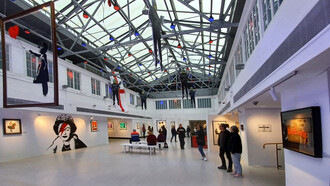Andrea Spinelli was born in Arluno (MI) on 5th November 1990. After obtaining his diploma in Fine Arts, he carried on his research in painting and music. His 2016 has been exciting so far. Besides different exhibitions, he has had the chance to portray - live - many artists of the international music scene. His very personal live painting technique allowed us to talk and discover something more about his incredible idea.
When and how did you start depicting live musicians?
Good question. I often think about my first live paintings, but I never manage to find the very first one, as it all started gradually. I remember an afternoon in July while walking through some flea market stalls with my girlfriend and I noticed a copy of the ‘Hagakure’. I bought it and noticed it contained many short phrases and white spaces. That night I went to see Il Management Del Dolore Post Operatorio live and I carried the ‘Hagakure’ with me, in order to use it as a support to portray the band. If I think about this now, it all gains a romantic aura. I think this was my first live painting ever. I don’t think there is a particular reason why I started as I feel like I’ve always done it, often going to concerts with a sketchbook since I was in secondary school. I’ve always taken notes and drawn sketches of the things I had in mind, even outside live music. Besides, two years ago my own band LA NUIT split up (I was the drummer) and I started having back problems. I found it difficult to play, therefore I started to look for something that allowed me to express my artistic side in a different way, while still being part of the world I now consider as my own: music.
I assume you also paint different subjects. What are the main differences between still life, posed portraits and live painting, in your opinion?
You are right. They are very different on a technical and psychological level! When you portray someone or something in your own studio you can take all the necessary time, to make mistakes, start over and you have much more material to experiment with. When you draw live, above all during big music events, you have many more variants and they are similar to the ones you encounter while playing live with a band: you have times to respect, discretion and attention to keep up and a certain pressure due to the amount of people surrounding you. However, the main difference (which is also its added value) is that when you paint live you also live a very exciting moment.
Which positive (and possibly negative) characteristics does live painting have and what can you tell us about your relationships with the different musicians you have portrayed?
You are talking about something very moving. Thanks to this mad project I have managed to get in touch with wonderful people I have always wanted to meet. The artists are always curious and surprised about what I do. I received many compliments for the project and its originality and many are now following what I do. I have started to collaborate with some of them, creating artwork and merchandising. For example, the artwork I created for the busker Milanese Soltanto and the prints I created for Daniele Celona, that he decided to take on tour with him. I can’t think about negative aspects, as I’m living it all as if it were a dream come true and a huge personal and artistic growth.
Can you tell us some remarkable anecdotes about your year on the road?
Ahahah, there are plenty! Like the arm wrestling with Daniele Celona in order to obtain his portrait (ended in a draw); or the time I managed to show Eugene Robinson my portrait of him at the Bloom club in Mezzago and he decided to write an article about my project. The funniest fact is that many of them would like to take my painting home and this leads to amusing situations! Something incredible happened in July, during the Ritmo Delle Città Festival: after the concert I showed my portrait to Antonella Ruggiero and when I started to explain my work she started talking about it to the people around us. I was stone cold! A legend of Italian music was actually talking about my project thoroughly! It was incredible.
How do you think the project will evolve and what are your future projects?
I have started collaborating with different realities and people. I would like to take my live painting to art schools and universities, in order to show the potential of this project, to show a different point of view than the academic one. Furthermore, I would like to make my live painting more interactive possibly by video projecting what I do during a concert. At the moment, I am recording my performances live with the help of the professional videomaker, Antonio D'Andrea: the idea is to start collaborating with television and the Internet. However, the most important thing to me - at the moment - is to work with my live painting abroad. Then, who knows… thanks to this experience, I have learned that you never know what’s around the corner, especially when it comes to wonderful things.















